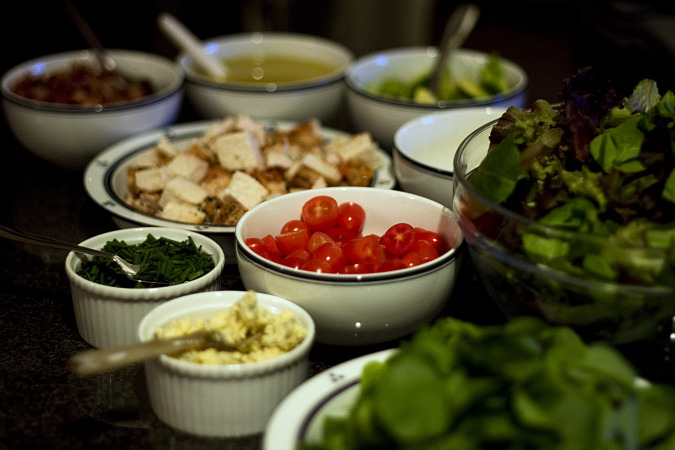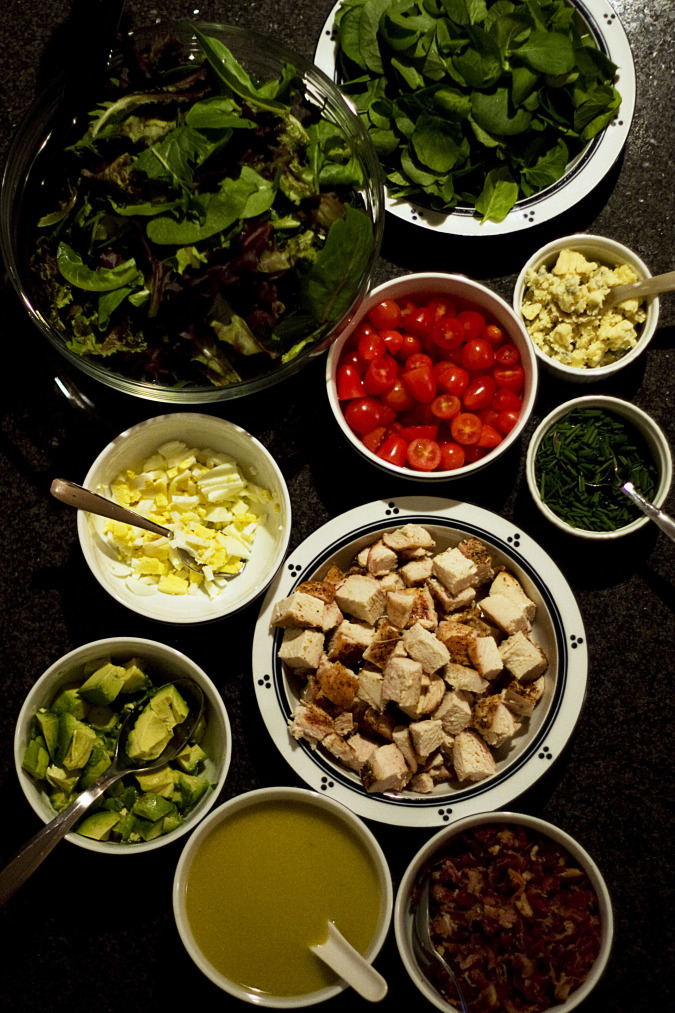 Cobb Salad photo by Loren Tama
Cobb Salad photo by Loren Tama
I’ve eaten Cobb salads for dinner, breakfast, and lunch, sometimes successively and usually in that order. I love the crunch, the tanginess, and the complements achieved by the right balance of acidic tomatoes, sweet and smoky bacon, and fragrant blue cheese. A properly-seasoned chicken breast can make the difference between a lame Cobb and a gourmet delight.
I’ve been known to praise restaurants that use a traditional Cobb dressing, complete with blue cheese, garlic, Worcestershire, and vinegar. At the same time, I’ve often lambasted a Cobb served with something as pedestrian as thousand island dressing: pounding my fist on the table, I lecture my fellow diners, reciting my familiar phrase “it’s not a Cobb without Cobb dressing!” As much as I’d like to say that the dressing makes the Cobb, however, the reality is that all the components need to come together in perfect harmony.
The ingredients can be varied to ones’ liking. Not much is lost by using turkey bacon rather than pork. I find that heirloom tomatoes bring too much liquid to the table, and prefer small, acidic cherry tomatoes or the like. Sometimes I cut them in halves or quarters, sometimes I leave them whole. When small yellow tomatoes are ripe, they bring an interesting sweetness to the dish.
Chicken is traditionally the primary protein. I find that turkey lacks the requisite flavor, beef tends to detract from the dish, and most fishes cannot stand up to the tangy dressing (although poached trout plays nicely with the acidity, but should not be cut before serving). Too frequently I find a Cobb served with limp, processed turkey. It makes me want to cry.
Avocado mellows the sourness nicely, and boiled eggs – chopped into squares, sliced, or grated – offer an interesting element, but only if not over-boiled. Poached eggs do not work well. The chives add pleasant aromatics, and should not be omitted. In terms of lettuce, there are many variations that work well. I’ve used iceberg, but I like the complexity of mixed greens. I always – and I mean always – include watercress, either in whole form or finely chopped. Watercress should usually be leafed to exclude stems, although chopped stems introduce a delightful crunchiness.
When it comes to the cheese, I haven’t had any complaints using various blues and Roqueforts, but my palate prefers a sharp and salty blue, such as Roaring 40s. As for the dressing, I recently tried a fast, lower-calorie version from Cooks Illustrated, but it didn’t offer the tanginess or overall roundness I was looking for. In the future, I’ll stick with Irma Rombauer’s recipe from the Joy of Cooking. Irma’s dressing is superb the next day, after the ingredients have had time to mingle (aside: I wonder what would happen if I marinated chicken in a Cobb dressing?).
I frequently make the Cobb at home. It is a fantastic dish to serve to casual, health-conscious guests, and ideal when vegetarians come to visit. I usually serve the components separately in a “build your own Cobb” style…and I always sneak Worcestershire in the dressing without hinting the secret to the vegetarians. It’s a great leftover salad, often appearing on my desk at work – sometimes well before lunchtime.
According to various sources, Wikipedia included, the Cobb salad was invented by Robert Cobb at the Brown Derby restaurant circa 1927. I am not qualified to discuss the merits of this history, nor is it the purpose of my writings; however the Cobb salad came to be, I want to thank the person responsible.
So without further adieu:
Thank You, Bob Cobb, for providing culinary satisfaction that has endured the ages.
 Cobb Salad Table photo by Loren Tama
Cobb Salad Table photo by Loren Tama
